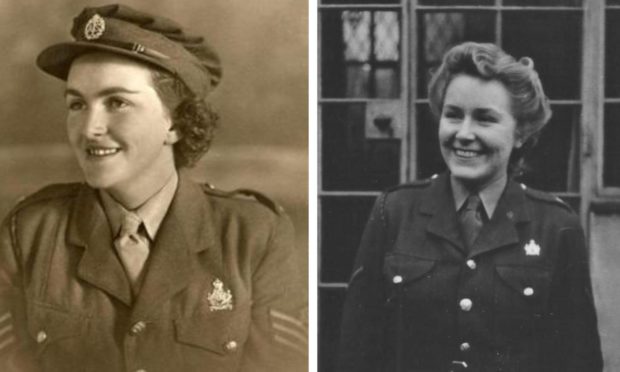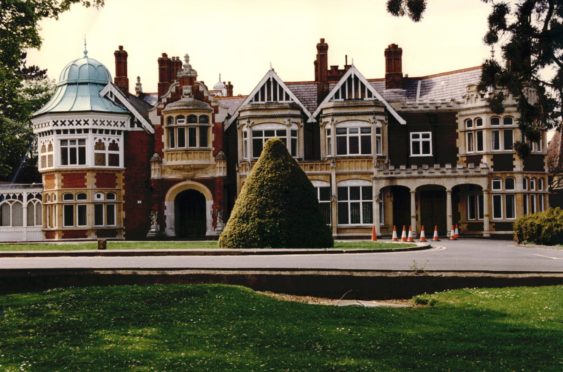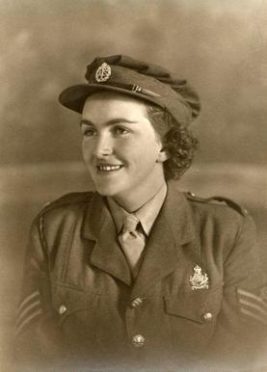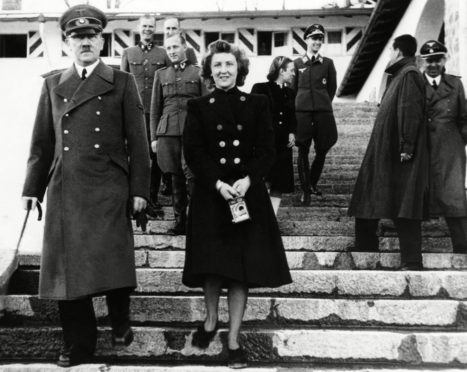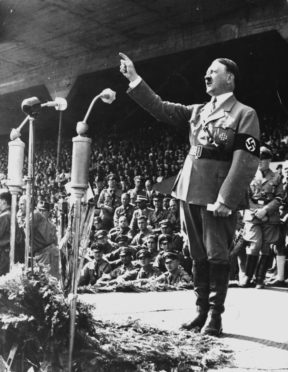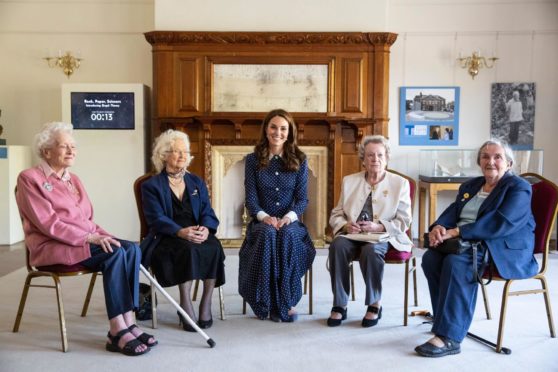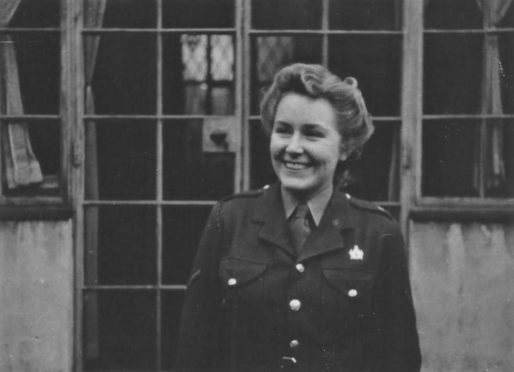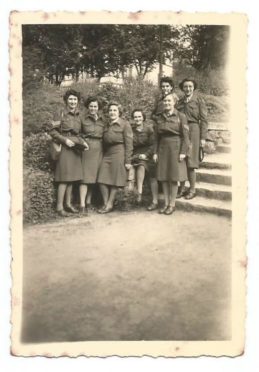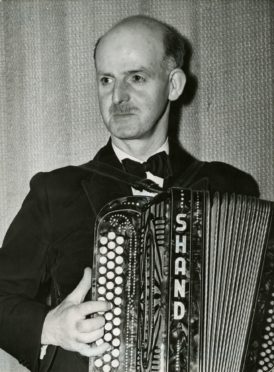Fife woman Rena Stewart and Dundonian Margery Forbes joined forces to translate Nazi tyrant Adolf Hitler’s last will and testament.
They became firm friends when they joined the Auxiliary Territorial Service (ATS) which tasked women with a range of vital roles during the Second World War.
The St Andrews University languages graduates would go on to work at Bletchley Park to break the codes of intercepted Nazi communications after MI6 famously decided to turn to cryptic crossword solvers to crack Germany’s encrypted secrets.
Following Germany’s surrender, Rena and Margery were sent to work in the Bad Nenndorf interrogation centre where they translated the written statements of prisoners who were mostly former Nazi party members or SS and Gestapo officers.
The pair were tasked with an extra assignment of delivering an “absolutely accurate” translation of a document that turned out to be Hitler’s will.
And they were not to tell anyone about it.
Margery took her secret to the grave when she died in 1973 but Rena is still alive to tell the incredible story of how they became top secret code crackers.
A friendship forged at Bletchley Park
“I met Margery in November 1943 when we joined the ATS,” said Rena, 97, who was born in Lundin Links.
“We were told that we were being sent to a very secret place – so secret that we would never be able to talk about it and if we didn’t want to do that, they would find another posting for us.
“Who could have chosen that alternative?
“On arrival at Bletchley we were allocated to the German Book Room, along with another Scottish graduate, Elma Morley.
“We were allocated a small room off the main office.
“We were typing the decrypts in German, but of course that job came to an abrupt end when the war ended.
“But we were not due to be demobbed for another 18 months, which is why we were transferred to Germany and by then Margery and I were firm friends.
“We were allocated together to a unit where our job was to translate the prisoners’ hand-written statements.
“The head of the unit was Major Bill Oughton, who turned out to be a close friend of the historian Hugh Trevor-Roper.
“Trevor-Roper was in the army at the head of the Intelligence Corps in Germany.
“One day Major Oughton entered our office, looking very solemn.
“He said: ‘I want you to stop doing whatever you are doing and work together on translating this document.
“‘Take as long as you like, but there must be no mistakes and you must agree on all details’.
“We were not to tell anyone about it.”
Rena said it was obvious it was Hitler’s will as the discovery of the documents had recently been widely reported.
“They were not legal documents but simply saying what he wanted to happen after his death,” she said.
“They were left in the bunker where the suicides of Hitler, Eva Braun and the Goebbels family took place.”
Hitler wrote up his will the day before he killed himself
Hunted by Soviet troops storming Berlin, Hitler retired to his underground bunker in January 1945 and knew that he would soon have to take his own life.
Before doing so, he got married to his long-time mistress, Eva Braun, and signed his final political testament and personal will on April 29 1945.
The will was a short document stating that he and his wife had chosen death over capitulation, and that they were to be cremated.
Hitler shot himself in the head, while Eva died instantly when she bit down on a cyanide capsule.
“The bunker was reached first by the Russian army and at first they didn’t let anyone else see the documents,” said Rena.
“One was about what he wanted to happen in the political field, the other – which was much shorter – was what he wanted to happen to his family.
“That was the one we were to translate.
“I can’t remember how long it took, but we discussed every nuance and all the alternatives.
“I remember particularly discussing how we should translate ‘kleinbuergerlich’.
“The context was that Hitler said he didn’t expect his entire fortune to go to his family, but he wanted them to get enough to lead a ‘kleinbuergerlich’ life.
“The dictionary we consulted defined it as ‘lower middle-class’.
“We didn’t like the sound of that, we felt it was too derogatory so we thought that ‘petit bourgeois’ was better.
“But, uneasy about translating one foreign phrase with another, we put ‘kleinbuergerlich’ in brackets.
“It was this that made me realise, several years later, that Trevor-Roper had used our translation when his book The Last Days of Hitler was published.
“We also discovered that Bill Oughton was a great friend of Trevor-Roper.
“But it still didn’t account for why TR needed another translation.”
Document was included in 1947 book on Hitler’s final days
Trevor-Roper’s 1947 book emerged from his assignment as a British intelligence officer in 1945 to discover what happened in the last days of Hitler’s bunker.
From his interviews with a range of witnesses and study of surviving documents he demonstrated that Hitler was dead and had not escaped from Berlin.
Rena said: “At the time Margery and her family were living in Fulham and I saw her quite often.
“Excitedly I phoned her but she took the news quite calmly and immediately started talking about our next meeting!”
Later in 1946, Rena returned to Britain and was demobilised.
Her efforts to find employment were hampered as she was unable to tell anyone what she had done during the war.
She eventually became the first woman to reach the grade of Senior Duty Editor in the BBC World Service.
She now lives in London.
Margery Forbes’ secret was discovered decades later
Margery got married in 1947 to Marion Jozef Tarwinski, a tank driver and engineer, who was one of many Poles serving over in Scotland during the war.
The couple had three children.
Wanda was born 1948, Rena in 1954 and Edmund in 1956.
Rena was named after her great friend and colleague from Bletchley Park.
The family emigrated to Ontario, Canada, in 1957, then moved to Ohio, USA, in 1959, where Marion sadly died of heart failure in 1962.
Margery returned to Dundee with her children in 1964.
She was a popular teacher of languages at Harris Academy and then at Morgan Academy until 1972.
She was involved in leading groups of pupils to Barcelona for summer outings with a heavy emphasis on culture, language and education, which were memorable trips on which her three children happily tagged along.
She died of cancer in 1973 and it was a chance meeting some decades later that led her children to discover the truth about her secret role in World War Two.
Family are extremely proud of Margery’s wartime exploits
Margery’s son Ed Tarwinski said the family is extremely proud of her achievements and the Hitler story is a guaranteed show-stopper at dinner parties!
“Our mother unfortunately died of cancer in February 1973, aged 49,” said Ed.
“Being bound by the Official Secrets Act, she was not able, during her lifetime, to tell us what she did during the war, saying only that is was a secret.
“Just a few years after her death the information was declassified and books appeared about Bletchley Park, and what had gone on there, and what was achieved.
“But of course we knew nothing then about our mother’s involvement.
“Around 1995, during the course of my business, I had an appointment to visit a lady in Ravelston, Edinburgh.
“Miss Morley, intrigued by my surname Tarwinski, asked me what my mother’s first name was.
“When I replied with ‘Margery’, Miss Morley excitedly revealed that she and my mother had been close colleagues and good friends during the war, and she proceeded to produce a box of photographs and mementoes.
“This was quite a moment for me, as I had never before met one of my mother’s old friends.
“And this, as far as I recall, was when I first learned that my mother worked at Bletchley Park.
“After showing me a selection of fascinating photos and other keepsakes, Miss Morley then told me that the person I really should speak to would be Rena Stewart.
“Apparently Rena and my mother were best buddies during and after the war and that Rena would have more stories, photos and mementoes.
“It later turned out that my late sister Rena, who sadly died in 2013, was named in honour of Rena Stewart.
“So I thanked Miss Morley for the revelations and put myself in touch with Rena, who lived in west London and had retired after a post-war career at the BBC World Service.
“After a number of letters and copies of documents and photos were exchanged, we both filled in the gaps in our knowledge of Margery’s life during and after the war.
“And so it was through Rena that I learned of the Hitler’s will story.
“My sister Wanda Drysdale and I, and our sister Rena before she died, have all visited Bletchley at various times, where Margery now has her own brick in the memorial wall.
“We are very proud of her being selected for the very important work that was done at Bletchley, and also the fact that she kept the secret safe, even from her own family.
“The Hitler’s will story is a strange one, but is guaranteed as a show-stopper at dinner parties!”
Margery’s family’s links to Hitler go back further
Born in Dundee in 1923, Margery was the daughter of Lilian and Charles Forbes, the music seller who helped Sir Jimmy Shand in his early years.
Margery’s father Charles first gave Sir Jimmy a job in his King Street store after Sir Jimmy asked to try one of the instruments on display in the window.
Sir Jimmy was already on the road to stardom when he and Charles set about designing a method of reducing the number of pallets on the three-row button keyed accordion.
They met with German instrument manufacturer Hohner’s chief designer, Venanzio Morino, and they built and designed a prototype to create his unique sound which was called the Hohner Special.
Hitler gave the nod for the specially-made instrument to be exported to Sutherland Street in Dundee after it was caught up in delays as the Second World War approached.
